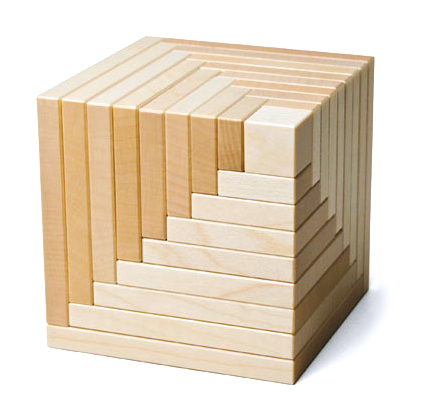

Title: Cella Wooden Pieces Game Of Spatiality Temple Cube By Naef Art
Shipping: $29.00
Artist: N/A
Period: Contemporary
History: N/A
Origin: N/A
Condition: Museum Quality
Item Date: 2000 to 2013
Item ID: 6079
Made By Naef: Consignment / This order takes between four and six weeks to receive / Cella Hide and seek in the cube of the cube of the cube... The smallest unit within a cell, or the most sacred chamber of an ancient temple – Cella symbolizes this path. Nine half cube shells create a game of spatiality with almost endless possibilities. Product information: 10 x 10 x 10 cm 9 pcs. Design: Peer Clahsen Article number: Art.-No. 9608 Cella nature Art.-No. 9608.1 Cella red Art.-No. 9608.2 Cella blue Art.-No. 9608.3 Cella grey Designed by Peer Clahsen in 1979 for Naef Toys, Switzerland. One of our best selling Naef toys! Make your own op-art masterpiece in the style of Vasarely or a futuristic space ship, everything is possible! Cella was made after the smallest unit within a cell, or the most sacred chamber of an ancient temple - Cella symbolizes this way. Nine divisible shells fit into each other to make chambers and rooms, flowers and leaves. Look, play and be amazed! Cella guarantees hours of fun! Not for children under 3 years old. This item can be gift wrapped. Play cubic hide-and-seek with this approximately 4 in. (10 cm) maple wood cube designed by Peer Clahsen. Nestled inside the outer cube is...another cube, then another cube...then another – well, you get the idea. Cella can be said to symbolize the journey from the material to the spiritual world, just as people in ancient cultures could only reach the divinity by penetrating the innermost sacred chamber of the temple. Nine half-cube shells in Cella create a mind-bending game of spatial exploration with endless permutations. Naef products are hand-made and finished in Switzerland to the highest standards of design and construction. Unlike the disposable quality of similar products manufactured today, these are heirloom pieces meant to endure and remain in use for generations. *Naef Toys: The individual parts allow you to create again and again something new. The company has the highest level of excellence and quality. Naef wooden toys; or as we like to refer to them as “Objects or Art” to our avid followers. We plan to maintain our unprecedented reputation for quality and customer service in order to maintain the Naef name and tradition well into the future. Every Naef item is sold with the full intent of bringing enjoyment to the customer. Our product’s specifically selected woods and superior Swiss craftsmanship allow for them to last beyond a single generation. Naef is more than just a toy; it is the piece of family history that will be passed down from generation to generation. *All of the art is edited and chosen by us for its high quality and workmanship before posting. These collectibles have been selected with the artist & collector in mind. We are committed to enhancing our customer’s lives by discovering creating, and pointing out only the best art we can find in the world today. We Are Taste-Makers, Art Advisers, Consultants & Publishers Of Spectacular Art Stories. Our job is to be intermediaries between buyers and sellers. We are vetting for high end art patrons. We are determined to catalog the world's most exceptional art and share it with everyone.
Link: http://en.wikipedia.org/wiki/Toy
Designer toys are toys and other collectibles produced in limited editions (as few as 10 or as many as 2000 pieces) and created by artists and designers.
Most young humans have been said to play with whatever they can find, such as pine cones and rocks. Toys and games have been unearthed from the sites of ancient civilizations. They have been written about in some of our oldest literature. Toys excavated from the Indus valley civilization (3000-1500 BCE) include small carts, whistles shaped like birds, and toy monkeys which could slide down a string.
The earliest toys were made from materials found in nature, such as rocks, sticks, and clay. Thousands of years ago, Egyptian children played with dolls that had wigs and movable limbs which were made from stone, pottery, and wood. In Ancient Greece and Ancient Rome, children played with dolls made of wax or terracotta, sticks, bows and arrows, and yo-yos. When Greek children, especially girls, came of age it was customary for them to sacrifice the toys of their childhood to the gods. On the eve of their wedding, young girls around fourteen would offer their dolls in a temple as a rite of passage into adulthood.
As technology changed and civilization progressed, toys also changed. Where as ancient toys were made from materials found in nature like stone, wood, and grass, modern toys are often made from plastic, cloth, and synthetic materials, often powered by batteries. Ancient toys were often made by the parents and family of the children who used them, or by the children themselves. Modern toys, in contrast, are often mass-produced and sold in stores.
The materials that toys are made from have changed, what toys can do has changed, but the fact that children play with toys has not changed.